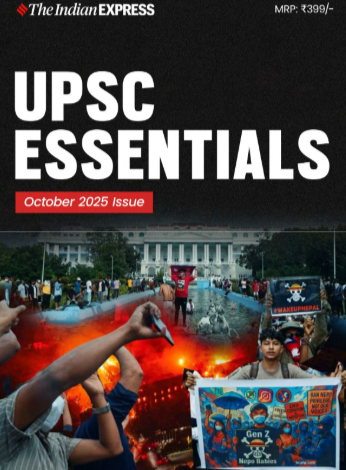Priya Kumari Shukla is a Senior Copy Editor in the Indian Express (digital). She contributes to the UPSC Section of Indian Express (digital) and started niche initiatives such as UPSC Key, UPSC Ethics Simplified, and The 360° UPSC Debate. The UPSC Key aims to assist students and aspirants in their preparation for the Civil Services and other competitive examinations. It provides valuable guidance on effective strategies for reading and comprehending newspaper content. The 360° UPSC Debate tackles a topic from all perspectives after sorting through various publications. The chosen framework for the discussion is structured in a manner that encompasses both the arguments in favour and against the topic, ensuring comprehensive coverage of many perspectives. Prior to her involvement with the Indian Express, she had affiliations with a non-governmental organisation (NGO) as well as several coaching and edutech enterprises. In her prior professional experience, she was responsible for creating and refining material in various domains, including article composition and voiceover video production. She has written in-house books on many subjects, including modern India, ancient Indian history, internal security, international relations, and the Indian economy. She has more than eight years of expertise in the field of content writing. Priya holds a Master's degree in Electronic Science from the University of Pune as well as an Executive Programme in Public Policy and Management (EPPPM) from the esteemed Indian Institute of Management Calcutta, widely recognised as one of the most prestigious business schools in India. She is also an alumni of Jamia Milia Islamia University Residential Coaching Academy (RCA). Priya has made diligent efforts to engage in research endeavours, acquiring the necessary skills to effectively examine and synthesise facts and empirical evidence prior to presenting their perspective. Priya demonstrates a strong passion for reading, particularly in the genres of classical Hindi, English, Maithili, and Marathi novels and novellas. Additionally, she possessed the distinction of being a cricket player at the national level. Qualification, Degrees / other achievements: Master's degree in Electronic Science from University of Pune and Executive Programme in Public Policy and Management (EPPPM) from Indian Institute of Management Calcutta ... Read More
UPSC Key: Enforcement Directorate, Gadchiroli and Women in Indian Armed Forces
Why Tamil Nadu State Marketing Corporation (TASMAC) is relevant to the UPSC exam? What is the significance of topics such as Jal Jeevan Mission, Permanent Commission and Short Service Commission on both the preliminary and main exams? You can learn more by reading the Indian Express UPSC Key for May 23, 2025.
 UPSC Key May 2025: Here's what you should be reading from the May 23, 2025 edition of The Indian Express
UPSC Key May 2025: Here's what you should be reading from the May 23, 2025 edition of The Indian Express Important topics and their relevance in UPSC CSE exam for May 23, 2025. If you missed the May 22, 2025 UPSC CSE exam key from the Indian Express, read it here
FRONT PAGE
ED is crossing all limits, says CJI-led bench, stays probe against TASMAC
Syllabus:
Preliminary Examination: Indian Polity and Governance-Constitution, Political System, Panchayati Raj, Public Policy, Rights Issues, etc.
Mains Examination:
• General Studies II: Statutory, regulatory and various quasi-judicial bodies.
• General Studies II: Issues and challenges pertaining to the federal structure,
• General Studies III: Money-laundering and its prevention
What’s the ongoing story: Warning the Enforcement Directorate that it was “crossing all limits” and “violating the federal structure”, the Supreme Court Thursday stayed proceedings in the agency’s money-laundering investigation into government-run liquor retailer Tamil Nadu State Marketing Corporation (TASMAC).
Key Points to Ponder:
• Why Supreme Court Warned the Enforcement Directorate?
• What is Tamil Nadu State Marketing Corporation (TASMAC)?
• Enforcement Directorate is a statutory body-True or False?
• Directorate of Enforcement (ED) comes under which Ministry or Organisation?
• The Directorate of Enforcement is a multi-disciplinary organization mandated with investigation of offence of money laundering and violations of foreign exchange laws. The statutory functions of the Directorate includes enforcement of certain acts-What are those acts?
• What makes Enforcement Directorate so powerful?
• The significant increase in ED cases is mainly attributed to the Prevention of Money Laundering Act (PMLA)-Discuss
• Why these days the Enforcement Directorate (ED), National Investigation Agency (NIA), Central Bureau of Investigation (CBI), Narcotics Control Bureau (NCB), are in the limelight?
Key Takeaways:
• The bench of Chief Justice of India B R Gavai and Justice A G Masih, which was hearing the Tamil Nadu government’s plea challenging the ED searches at the TASMAC headquarters, sought a reply from the probe agency within two weeks.
• Appearing for the state, Senior Advocate Kapil Sibal said the corporation had found that some people who had been allotted liquor outlets were taking cash. “So the state itself filed 41 FIRs from 2014 to 2021. Against individuals, not against the corporation. The ED comes into the picture in 2025 and raids the corporation, the head office,” he said.
• Issuing notice, CJI Gavai asked Additional Solicitor General S V Raju, who appeared for the ED: “How can (there be) an offence against the corporation?… You may register (an offence) against individuals, how (against the) corporation in a criminal matter?”
• The bench directed that in the meantime, there will be a stay on further proceedings against the petitioners.
• Senior Advocate Mukul Rohatgi, appearing for TASMAC said the agency had taken the phones of employees and cloned them.
• Sibal and Rohatgi urged the court to direct the ED not to use the data collected. “They have taken our data. The data cannot be used,” Sibal said. “There is something called privacy,” Rohatgi said.
Do You Know:
• The ED’s PMLA case stemmed from allegations of corruption and irregularities in TN’s liquor sales. In March this year, the ED conducted searches at multiple locations including the TASMAC headquarters. The state and the corporation came to the Supreme Court after being denied relief by the Madras HC.
• On April 23, the Madras High Court dismissed pleas filed by the State of Tamil Nadu and TASMAC challenging the ED’s searches. The High Court also rejected claims that TASMAC officials were harassed by ED during the searches.
• Formed in 1956, the ED became a prime agency following enactment of the Prevention of Money Laundering Act (PMLA) in 2002, implemented from July 1, 2005.
Other Important Articles Covering the same topic:
Previous year UPSC Prelims Question Covering similar theme:
📍Discuss how emerging technologies and globalisation contribute to money laundering. Elaborate measures to tackle the problem of money laundering both at national and international levels. (2021)
Forest clearance nod for iron ore plant in Maoist-hit Gadchiroli
Syllabus:
Preliminary Examination: Current events of national and international importance
Mains Examination: General Studies III: Conservation, environmental pollution and degradation, environmental impact assessment.
What’s the ongoing story: The Ministry of Environment, Forest and Climate Change has granted in-principle forest clearance for Lloyd Metals and Energy Limited’s iron ore beneficiation plant, a facility that improves the quality of raw ore by removing impurities, in Maharashtra’s Gadchiroli district where Maoists have been active for years.
Key Points to Ponder:
• Map Work-Gadchiroli district
• What are the key concern associated with granting environmental clearance for mining projects in ecologically sensitive areas like Gadchiroli?
• Which mineral is primarily associated with mining in Gadchiroli district?
• What are the environmental social implications of the Centre’s approval to fell over 1 lakh trees in LWE-affected Gadchiroli for an iron ore processing plant?
• Discuss about the balancing developmental needs with environmental protection in ecologically sensitive and tribal-dominated regions like Gadchiroli.
• How can mining-induced deforestation in tribal regions impact India’s forest cover goals and commitments under international climate agreements?
• Evaluate the role of the Forest Advisory Committee (FAC) in assessing the ecological viability of mining projects?
Key Takeaways:
• This in-principle approval paves the way for the diversion of 937 hectares of forest land and the felling of 1.23 lakh trees, according to Ministry documents.
• The forest clearance for the proposed plant comes amid the Maharashtra government’s push to expand mining and industrial activity in the district affected by Left Wing Extremism (LWE).
• Last month, the Maharashtra cabinet approved the establishment of a Gadchiroli District Mining Authority, chaired by Chief Minister Devendra Fadnavis, for the management of major and minor minerals. The district holds deposits of iron ore, limestone and diamonds.
• The beneficiation plant and allied facilities have been proposed to process low-grade iron ore (hematite quartzite) extracted from the company’s existing mining operations in Surjagarh, which faced operational hurdles for many years due to opposition from Maoists to any activity in the area.
• The mining lease, spread over 348 hectares, was initially granted to the company for 20 years in 2007 and was later extended until May 2057, according to company documents submitted to the Centre.
• The conditional in-principle approval was granted on May 12, following a recommendation of the Ministry’s forest advisory committee (FAC), which scrutinises proposals seeking forest clearances.
• The minutes of the FAC meeting show that compensatory afforestation for diversion of over 900 hectares of forest land has been proposed in Chiplun, Ratnagiri district on Maharashtra’s coast.
• One of the key conditions laid down is that the forest land has to be strictly used in a phased and regulated manner to “ensure environmental responsibility and sustainable development”. The 937 hectares has to be used in three phases with 300 hectares in the first phase, 200 hectares in the second phase, after compliance of the first phase.
Do You Know:
• In December 2016, Maoists torched 69 trucks and three earth movers at the Surjagarh mine in Gadchiroli – one of the biggest arson attacks by Maoists in the region. Before the 2016 violence, Jaspal Singh Dhillon, vice president of Lloyd Steel, was shot dead, allegedly by Maoists.
• Maoist insurgency in Gadchiroli has been ebbing gradually owing to operations of the state’s elite anti-Naxal commando force C60 as well as operations of the Central forces.
• Chief Minister Fadnavis spent the first day of the year in Gadchiroli, where 11 Maoists surrendered before him and he also inaugurated a 32-km long state transport bus service.
Other Important Articles Covering the same topic:
📍Naxalite footprint shrinking in Gadchiroli? cops say recruitment stopped, strength depleted
GOVT & POLITICS
Jal Jeevan: MPs flag ‘irregularities’ at meeting with minister, call for probe
Syllabus:
Preliminary Examination: Economic and Social Development
Main Examination:
• General Studies II: Welfare schemes for vulnerable sections of the population by the Centre and States and the performance of these schemes
• General Studies II: Important aspects of governance
What’s the ongoing story: A number of MPs on Thursday sought an investigation into the alleged irregularities in the implementation of the
government’s flagship Jal Jeevan Mission (JJM), The Indian Express has learnt.
Key Points to Ponder:
• What is the Jal Jeevan Mission?
• Jal Jeevan Mission comes under which Ministry?
• What is the issue highlighted in Jal Jeevan Mission ?
• What is the funding pattern of Jal Jeevan Mission?
• Is the Jal Jeevan Mission a centrally sponsored scheme?
• What is the issue highlighted by Expenditure Secretary-led panel?
• Why Expenditure Secretary-led panel proposed a 46 per cent cut in the Centre’s funding assistance to the Jal Shakti Ministry’s demand for four years ending December 2028?
• What are the factors which lead to the increment of per tap connection cost under the Jal Jeevan Mission from ₹30,000 to ₹1,37,500?
• How does Jal Jeevan Mission work?
• How Jal Jeevan Mission helps in empowering women?
• Jal Jeevan Mission (Urban) and Jal Jeevan Mission (Rural)-Compare and Contrast
• How important is the Jal Jeevan mission?
• What is Expenditure Finance Committee?
• What are the factors which constrains utilisation of Funds in Social Sector Schemes?
• What Steps/measures are needed for improving fund utilization capacity especially in schemes like Jal Jeevan Mission?
• How Funds are Allocated for Social Sector Schemes?
Key Takeaways:
• The demands were raised during an informal meeting, called by Jal Shakti Minister C R Patil, on the concerns raised by the MPs during a discussion on the ministry’s Demand for Grants for the financial year 2025-26.
• The meeting came days after the government issued an order for 100 inspection teams to fan out across 135 districts in 29 states and Union Territories to review the work under the scheme — amid concerns over cost overruns and alleged lapses in award of tenders. The JJM aims to supply drinking water through individual tap connections to rural households
• While Patil invited 60 Lok Sabha members, only 17-18 members turned up to the meeting at the Parliament House Annexe building, sources said
• The ministry did not issue an official statement. Patil posted on X that all MPs presented “constructive” suggestions.
• An Expenditure Secretary-led panel had recommended a 46 per cent cut in the Jal Shakti Ministry’s demand of Central funding of Rs 2.79 lakh crore for four years ending December 2028, amid concerns about some states approving inflated work contracts to provide tap water connections to rural households under the JJM.
• Since the launch of the scheme in 2019, 6.4 lakh water supply schemes with a total estimated cost of Rs 8.29 lakh crore — more than double the scheme’s original outlay of Rs 3.60 lakh crore (Centre: Rs 2.08 lakh crore, States: Rs 1.52 lakh crore) — have been approved by the states.
• To meet the additional requirement of funds, the Jal Shakti Ministry had approached the Expenditure Finance Committee, headed by the Expenditure Secretary, for approval of Rs 2.79 lakh crore in additional central funding over and above `2.08 lakh crore. However, the EFC recommended only Rs 1.51 lakh crore as the Central share, 46 per cent lower than the amount sought by the Ministry.
• On May 21, The Indian Express reported that an investigation of the data uploaded by states and UTs on the Jal Jeevan Mission dashboard showed that a crucial change in tender guidelines three years ago lifted the check on expenditure, and led to cost escalations. This resulted in additional costs totalling Rs 16,839 crore for 14,586 schemes, an increase of 14.58 per cent from their estimated cost.
• During Thursday’s meeting, Jal Shakti Ministry officials made presentations about various schemes including Jal Jeevan Mission and Namami Gange. It is learnt that the ministry will send written answers to the MPs who raised queries about central schemes. The ministry will likely organise a similar meeting with the MPs during the Monsoon session of Parliament.
Do You Know:
• The Jal Jeevan Mission, launched by Prime Minister Narendra Modi on August 15, 2019, aimed to provide tap connections to about 16 crore rural households to achieve saturation coverage by December end 2024. But only 75 per cent of the target could be achieved over five years, and the remaining 4 crore tap connections are now proposed to be installed by extending the mission by four years till December 31, 2028.
• In 2019 when the ‘Har Ghar Jal’ programme was launched, the EFC had fixed the Jal Jeevan Mission’s outlay at Rs 3.6 lakh crore against the Jal Shakti Ministry’s demand of Rs 7.89 lakh crore. Information available on the mission dashboard, however, shows states approved schemes worth Rs 8.07 lakh crore during the five years (2019-2024).
• This sharp escalation in costs probably led the EFC to curtail the outlay and reduce the Central share to the mission. Sources said the Jal Shakti Ministry justified the proposed cost of Rs 8.07 lakh crore for the approved scheme (which includes Rs 7.68 lakh crore of works awarded and Rs 38,940 crore of works at award stage) during the EFC meeting.
• According to the DEA, nearly 12 crore rural households were provided tap connections since 2019. The Centre and states spent Rs 3.60 lakh crore (Centre — Rs 2.08 lakh crore and states — Rs 1.52 lakh crore) for this. Now, the DDWS has projected the mission to cost an additional Rs 5.5 lakh crore (Centre — Rs 2.79 lakh crore, states — Rs 2.71 lakh crore) for providing tap connections to 4 crore households.
Other Important Articles Covering the same topic:
📍Justify increase in cost of tap to `1,37,500 from `30,000, says Finance
Previous year UPSC mains Question Covering similar theme:
📍What is water stress? How and why does it differ regionally in India? (2019)
EXPRESS NETWORK
Top Court pauses release of woman SSC officer part of Operation Sindoor
Syllabus:
Preliminary Examination: Indian Polity and Governance-Constitution, Political System, Panchayati Raj, Public Policy, Rights Issues, etc.
Mains Examination: General Studies I: Role of women and Social empowerment
What’s the ongoing story: The Supreme Court on Thursday asked the Indian Air Force not to relieve a woman Short Service Commission officer who had not been granted permanent commission and was part of the recent Operation Sindoor and Operation Balakot until further orders.
Key Points to Ponder:
• What is the promotion procedure in Indian Coast Guard, Army, Airforce and Navy?
• What is the role of women in Indian Armed Forces?
• “What role do males play in the Indian Armed Forces?-This question may appear strange, but if ‘What is the role of women in Indian Armed Forces’ appears normal, then this question should appear normal to all of us”—Discuss
• What percentage of Indian Armed Forces are women?
• Women in armed forces and their right to equality of opportunities-connect the dots
• How Principle of non-discrimination on the ground of sex under Article 15 and Right to equality of opportunity for all citizens in matters of public employment under Article 16 is applicable in the armed forces?
• What is the present scenario for the women entry in the Indian armed forces?
• first of all, what is permanent commission?
• Permanent Commission and Short Service Commission-Compare and contrast
• What is the procedure for granting permanent commission?
• What is number and percentage of women officers in Indian Army, Airforce and in the Indian Navy?
• Know the timeline of induction of women in the Indian Defence forces
• Why Women in the Indian defence forces should be given Permanent Commission?
Key Takeaways:
• A bench of Justices Surya Kant and N K Singh asked Additional Solicitor General Aishwarya Bhati, appearing for the Centre, why Wing Commander Nikita Pandey was denied permanent commission.
• Bhati said this was on account of the findings of a Board and that a second review Board is set to consider her case. She added that Pandey had directly approached the court seeking relief.
• The ASG said, “These are all brilliant officers. But the point is there is a comparative merit… We have a system by which we have to have certain officers going out after serving 14 years… it is the requirement of force to remain young.”
• “Our Air Force is one of the best organisations in the world. Officers are very commendable. Quality of coordination they have exhibited, I think it’s unparalleled. Therefore we always salute them. They are a big asset for the nation. Because of them, we are able to sleep at night,” said Justice Kant.
• Senior Advocate Menaka Guruswamy, appearing for Pandey, said that the Wing Commander is an expert fighter controller, who participated as an expert at the Managed Integrated Air Command and Control Systems, during Operation Sindoor and earlier, during Operation Balakot.
Do You Know:
• An officer in the Army is promoted to the rank of Colonel only after serving between 16 and 18 years, based on certain criteria such as annual confidential reports and various courses.
Women officers who were inducted into the Army were inducted as Short Service Commission (SSC) officers in 1992 and in the years after did not have the choice to opt for permanent commission. JAG and Army Education Corps were exceptions, where a permanent commission was opened for them in 2008.
For other arms and services, women could not become permanent cadre, and had to retire much before they completed the service period that is mandatory to become a Colonel.
• In 2019, the Army changed its rules allowing SSC women officers to opt for permanent commission who would have otherwise retired after 14 years of service. However, this was not retrospective, and applied only to the batches of women officers starting their career in the Army in 2020.
With the landmark Supreme Court judgment of February 2020, permanent commission was granted to women officers with retrospective effect. This opened the doors for their further growth and promotions in the Army, which has been of late opening leadership and higher management courses for women.
• Once promoted to a Colonel, an officer is eligible to command troops directly in the Army, which is an acknowledgment of the leadership qualities of the officer. It is considered a coveted appointment because in no other rank — including higher ranks like Brigadier or Major General — does an officer interact directly with troops on the ground.
Other Important Articles Covering the same topic:
📍Women get command roles in the Indian Army: why this is a remarkable achievement
Previous year UPSC Main Question Covering similar theme:
📍“Though women in post-Independent India have excelled in various fields, the social attitude towards women and feminist movement has been patriarchal.” Apart from women education and women empowerment schemes, what interventions can help change this milieu? (2021)
ECONOMY
RBI sold nearly $400 billion of foreign currency in FY25
Syllabus:
Preliminary Examination: Current events of national and international importance.
Mains Examination: General Studies III: Indian Economy and issues relating to planning, mobilization, of resources, growth, development and employment.
What’s the ongoing story: The Reserve Bank of India sold a record $398.71 billion of foreign currency in 2024-25 on a gross basis as the Indian central bank stepped up its defence of the rupee amid a volatile global environment.
Key Points to Ponder:
• What are the factors that led the Reserve Bank of India to sell nearly $400 billion of foreign currency in FY25?
• How RBI’s foreign exchange interventions in FY25 can impact on India’s foreign exchange reserves and overall economic stability?
• How effective can be RBI’s strategy in defending the Indian rupee during FY25?
• Know the implications of significant foreign exchange interventions on the Indian banking system’s liquidity and interest rate transmission.
• How did global political developments, particularly in the United States, influence the RBI’s foreign exchange policy decisions in FY25?
• Assess the role of forward sale commitments in the RBI’s foreign exchange management strategy.
Key Takeaways:
• The RBI’s sale of foreign currency in the spot market in the last financial year was sharply higher than the $153.03 billion it had sold in 2023-24 and the previous record of $212.57 billion in 2022-23, data released late Wednesday by the central bank showed.
• To be sure, the RBI also bought foreign currency heavily last year, resulting in a net sale of $34.51 billion for the 12 months ended March 2025. However, this was only the seventh time in the last three decades – data for which is available – that the central bank sold more foreign currency in a year than what it bought. Further, the $34.51 sold on a net basis in 2024-25 is second only to the $34.92 billion sold in 2008-09 during the global financial crisis.
• After a fairly stable couple of years, the rupee began weakening sharply in the second half of 2024-25 as it became increasingly likely Donald Trump would return to the White House as president of the US for a second term. The RBI’s interventions in the currency market peaked in December 2024 when it sold a massive $69.05 billion – the most it has ever sold in a month.
• All in all, the RBI sold $291.03 billion – or 73 per cent of its full-year gross sales – in the second half of 2024-25 as the panic caused by Trump’s protectionist trade policies pushed the rupee to an all-time low of 87.95 per dollar in early February 2025.
Do You Know:
• The RBI’s defence of the rupee was not without its cost, with India’s foreign exchange reserves slumping by around $80 billion betweeen late September 2024 and mid-January 2025 to under $625 billion. To attract more capital inflows, the then RBI governor, Shaktikanta Das, announced in December 2024 that the ceiling on interest rates banks can offer on so-called Foreign Currency Non-Resident (Bank) – or FCNR(B) – deposits was being raised by 150 basis points until March 2025. One basis point is a hundredth of a percentage point.
• However, data released Wednesday by the RBI showed the relaxation seems to have made very little difference, with total inflows in the aforementioned FCNR(B) deposit scheme in 2024-25 amounting to $7.08 billion compared to $6.37 billion in 2023-24.
Other Important Articles Covering the same topic:
📍RBI adds 57.49 tonnes of gold to forex kitty in FY25, brings 38.64 tonnes back to India
EXPLAINED
Syllabus:
Preliminary Examination: Current events of national and international importance
Mains Examination: General Studies III: Conservation, environmental pollution and degradation, environmental impact assessment.
What’s the ongoing story: The latest population estimation exercise in Gujarat has recorded 891 lions, a 32% jump in population since 2020. In these five years, lions have also expanded their range by 17% — from 30,000 to 35,000 sq km — and now cover 58 talukas (up from 53 in 2020) in 11 districts.
Key Points to Ponder:
• How are Asiatic lions different from other lions?
• What is the conservation status of the Asiatic lions?
• What are the strategies adopted by the government to mitigate human-animal conflict?
• Map Work-Gir National Park
• What is a significant ecological concern associated with the increasing lion population in Gujarat?
• What are the implications of the 32% rise in the Asiatic lion population in Gujarat between 2020 and 2025?
• What are the challenges associated with the relocation of Asiatic lions to other states, as directed by the Supreme Court?
• Evaluate the effectiveness of ‘Project Lion’ in addressing the conservation needs of Asiatic lions in India.
• Assess the role of community participation in the conservation of Asiatic lions in the Saurashtra region.
Key Takeaways:
• While announcing the numbers on Wednesday (May 21), Gujarat Chief Minister Bhupendra Patel proudly noted that the increase in the lion population is a result not only of favourable geographic and climatic conditions but also of the state government’s consistent and dedicated efforts. For this success story to continue, however, more needs to be done.
• From under 200 in the 1960s when their last home in Gir was accorded special protection, Asiatic lions have made a remarkable recovery. For most parts, this journey has been slow and steady — the population did not cross the 300-mark until 1995 when the lion broke free from the safety of the forests.
• Between 1990 and 2005, the lion’s range doubled from 6,600 sq km to 13,000 sq km. But in those early days of breaking new ground, the expansion of lions’ range resulted only in a modest 26% jump in numbers, from 284 to 359.
• In the next 15 years, though, as the lion once again doubled its range from 13,000 sq km to 30,000 sq km, already established satellite populations added up to record an overall jump of 88% in lion numbers from 359 to 674.
 Lion Census data.
Lion Census data.
• The latest estimation confirms that trajectory. However, this is only the second instance after the 2015 estimation when the population growth rate exceeded the rate of range expansion. It must also be mentioned that the absolute numbers offered without a standard error range are unusual for any scientific estimation method.
Do You Know:
• The lions have colonised at least three new areas — Barda wildlife sanctuary, Jetpur and Babra-Jasdan — in the last five years. A nearly 900-strong population scattered across 358 locations strengthens the species recovery trend that made IUCN change the Asiatic Lion’s status from “critically-endangered” to “endangered” in 2008.
• A closer look at the numbers, however, shows that the population growth has not been commensurate with the expansion of the lion’s range over the decades. Since 1990, the lion’s range has expanded by 430%, but the corresponding jump in numbers, at 214%, has not been half as swift.
• This is because the Saurashtra peninsula has very few protected wilderness areas — Gir National Park and a few small sanctuaries such as Pania, Girnar, Mitiyala and the recently colonised Berda — for the lion to flourish.
• Over decades, as these sanctuaries have neared their carrying capacity, lions wandering out for space have reached wasteland, farmland and agri-plantations, interspersed with clumps of natural vegetation tagged as forest patches.
• Even on government records, only 56% of Gujarat’s 891 lions were found in forested areas. While the relevant data is missing in the latest census, the 2020 report showed that the lion’s population density drops from 15.2 per 100 sq km in forested areas to just 1.65 in non-forested areas.
• Non-forest areas close to human habitations are not the ideal habitat for a large carnivore species. A former chief wildlife warden of the state acknowledged that there are “covert cases” of retaliatory killings when lions died of electrocution, “drowning in wells” or were “shot in self-defence”.
Other Important Articles Covering the same topic:
📍How Gujarat counted its Asiatic lions: 35,000 square km, 11 districts, 3,000 people
Previous year UPSC Prelims Question Covering similar theme:
1. Consider the following statements: (UPSC CSE 2019)
1. Asiatic lion is naturally found in India only.
2. Double-humped camel is naturally found in India only.
3. One-horned rhinoceros is naturally found in India only.
Which of the statements given above is/are correct?
(a) 1 only
(b) 2 only
(c) 1 and 3 only
(d) 1, 2 and 3
| PRELIMS ANSWER KEY |
| 1.(a) |
For any queries and feedback, contact priya.shukla@indianexpress.com
Subscribe to our UPSC newsletter. Stay updated with the latest UPSC articles by joining our Telegram channel – IndianExpress UPSC Hub, and follow us on Instagram and X.
UPSC Magazine

Read UPSC Magazine





- 01
- 02
- 03
- 04
- 05



























